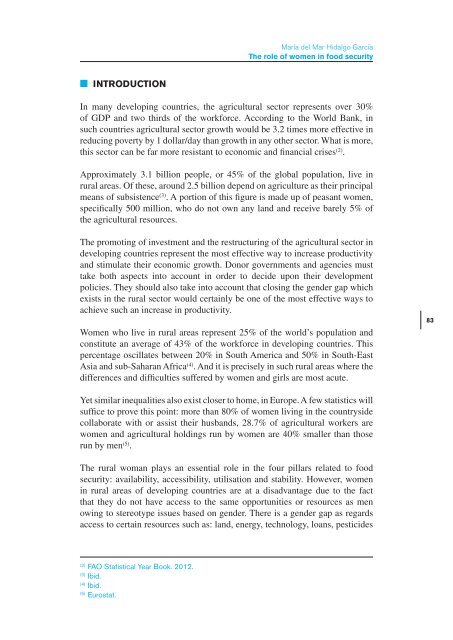Food security and global security - IEEE
Food security and global security - IEEE
Food security and global security - IEEE
- No tags were found...
You also want an ePaper? Increase the reach of your titles
YUMPU automatically turns print PDFs into web optimized ePapers that Google loves.
María del Mar Hidalgo GarcíaThe role of women in food <strong>security</strong>■■INTRODUCTIONIn many developing countries, the agricultural sector represents over 30%of GDP <strong>and</strong> two thirds of the workforce. According to the World Bank, insuch countries agricultural sector growth would be 3.2 times more effective inreducing poverty by 1 dollar/day than growth in any other sector. What is more,this sector can be far more resistant to economic <strong>and</strong> financial crises (2) .Approximately 3.1 billion people, or 45% of the <strong>global</strong> population, live inrural areas. Of these, around 2.5 billion depend on agriculture as their principalmeans of subsistence (3) . A portion of this figure is made up of peasant women,specifically 500 million, who do not own any l<strong>and</strong> <strong>and</strong> receive barely 5% ofthe agricultural resources.The promoting of investment <strong>and</strong> the restructuring of the agricultural sector indeveloping countries represent the most effective way to increase productivity<strong>and</strong> stimulate their economic growth. Donor governments <strong>and</strong> agencies musttake both aspects into account in order to decide upon their developmentpolicies. They should also take into account that closing the gender gap whichexists in the rural sector would certainly be one of the most effective ways toachieve such an increase in productivity.Women who live in rural areas represent 25% of the world’s population <strong>and</strong>constitute an average of 43% of the workforce in developing countries. Thispercentage oscillates between 20% in South America <strong>and</strong> 50% in South-EastAsia <strong>and</strong> sub-Saharan Africa (4) . And it is precisely in such rural areas where thedifferences <strong>and</strong> difficulties suffered by women <strong>and</strong> girls are most acute.83Yet similar inequalities also exist closer to home, in Europe. A few statistics willsuffice to prove this point: more than 80% of women living in the countrysidecollaborate with or assist their husb<strong>and</strong>s, 28.7% of agricultural workers arewomen <strong>and</strong> agricultural holdings run by women are 40% smaller than thoserun by men (5) .The rural woman plays an essential role in the four pillars related to food<strong>security</strong>: availability, accessibility, utilisation <strong>and</strong> stability. However, womenin rural areas of developing countries are at a disadvantage due to the factthat they do not have access to the same opportunities or resources as menowing to stereotype issues based on gender. There is a gender gap as regardsaccess to certain resources such as: l<strong>and</strong>, energy, technology, loans, pesticides(2)FAO Statistical Year Book. 2012.(3)Ibid.(4)Ibid.(5)Eurostat.
















